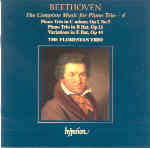Volume 4 of the Florestan Trio’s traversal of the complete Beethoven Piano Trios is as good as its predecessors, which is to say that it’s now the preferred version of these works on disc. The CD opens with the early Op. 1 No. 3 Trio, but there’s nothing “early” or demurely “Classical” about this large-scale, volatile composition, which is full of surprises that still shock. The Florestans lend the opening its full measure of mystery, and the passionate outbursts that interrupt passages hinting of tragedy and longing are flawlessly accomplished without ever sounding fragmented or sectional. The flowing tempo the ensemble adopts for the Adagio cantabile has a feeling of inevitability about it, as do the gear shifts in the opening movement, the explosiveness of the third movement, and the rich variety of the finale.
The other big work here is the Op. 11 trio, originally written for clarinet, whose modified part was given to the violin in this alternative version made by Beethoven to increase sales. In contrast to the Op. 1 No. 3, it’s a relaxed, often downright genial piece. Nevertheless, the Florestan finds some fires to light in the opening Allegro, and the playing is wonderfully soulful in the Adagio movement. The finale is a set of variations on a jaunty number from a now-forgotten comic opera by Joseph Weigl, L’amor marinaro (Love at Sea), each variation beautifully delineated by the group.
Sandwiched between the larger works is the Variations in E-flat major Op. 44, on a banal theme from Carl von Dittersdorf’s opera Das rote Käppchen (The little red cap). It’s another example of Beethoven spinning gold, or at least silver, from base materials. Although not top-drawer Beethoven, it’s full of surprising twists and turns. You can imagine the composer writing it with a smile on his face, and the Florestan Trio plays it that way too.
Throughout, the ensemble’s playing is superbly accomplished. Susan Tomes’ pianism is a real treat, with idiomatic phrasing, precisely articulated rhythm, and nicely rounded tone at all dynamic levels. That her string partners are in her league says much about the group’s talents. The engineers provide life-like sound, though it takes a volume boost to convert Anthony Marwood’s violin tone from wiry to full-bodied. [2/25/2005]
































